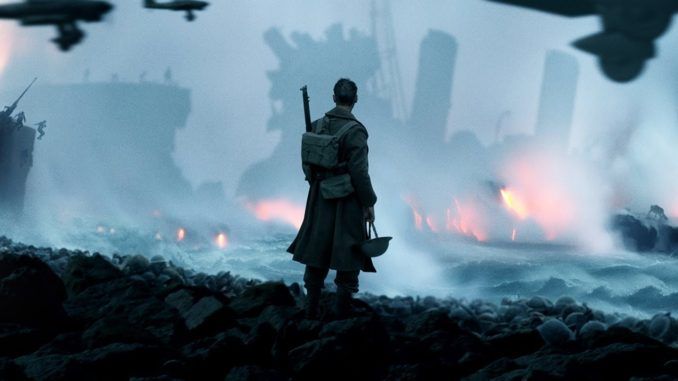
Rating: C
Dir: Christopher Nolan
Star: Fionn Whitehead, Tom Glynn-Carney, Tom Hardy, Harry Styles
It’s probably me. This is one of those films where I can appreciate the effort, understand the stylistic choices made, and be impressed by the technical aptitude. Yet it all still leaves me unmoved. Turns out there is a hard limit to the number of times I can see people either fall into, or be fished out of, the English Channel, before it begins to get old. It’s a fairly well-known story, at least in Britain. Early in WW2, hundreds of thousands of British soldiers, trapped in northern France, were evacuated by a flotilla of small boats that crossed the Channel to pick them up. The term “Dunkirk spirit” still gets used today.
Nolan seeks to tell the story from a range of different perspectives. On the beach is soldier Tommy (Whitehead), desperate to escape back to England, by any means necessary. Sailing towards Dunkirk in his little vessel, to help with the rescue, is Dawson (Glynn-Carney) . And patrolling the skies above them is Farrier (Hardy) and his colleagues, fending off the Luftwaffe dive-bombers despite limited fuel. I understand why the director went for this approach, and why he opted to focus on individuals at the bottom of the pile, rather than painting a bigger picture. For instance, Prime Minister Winston Churchill only shows up in a third-hand rendition of his “We shall fight them on the beaches” speech, read by a soldier from a newspaper.
 However, I didn’t feel all of them were sufficiently well-developed. Tommy, in particular, feels as generic a British soldier as his name would suggest. Nolan has also deliberately kept the dialogue to a minimum. Again, I see why, except there’s a reason why silent movies faded away. Not that this is exactly mute, of course, with Hans Zimmer’s droning score becoming overbearing by the end. What saves things is the visual side, Nolan certainly not short-changing his audience in the spectacle department. It’s impressive, because he doesn’t rely on sheer volume. While a third of a million men was rescued in total, you never see anything close to that, and rarely more than a couple of planes in the same shot. However, even simple things like Farrier landing on the Dunkirk sands are beautifully photographed.
However, I didn’t feel all of them were sufficiently well-developed. Tommy, in particular, feels as generic a British soldier as his name would suggest. Nolan has also deliberately kept the dialogue to a minimum. Again, I see why, except there’s a reason why silent movies faded away. Not that this is exactly mute, of course, with Hans Zimmer’s droning score becoming overbearing by the end. What saves things is the visual side, Nolan certainly not short-changing his audience in the spectacle department. It’s impressive, because he doesn’t rely on sheer volume. While a third of a million men was rescued in total, you never see anything close to that, and rarely more than a couple of planes in the same shot. However, even simple things like Farrier landing on the Dunkirk sands are beautifully photographed.
The lack of scale seeks to put the viewer there with the participants, be that in the air, on the ground, or most frequently, splashing about in the goddamn water again. There are times when this should have been titled Mermaids at War. But perhaps due to the three-way split of focus, I never felt invested in their fates. I’m not saying Nolan needed to use tired cinematic tropes like Tommy whipping out a picture of his girlfriend back in Blighty. However, an audience still needs to be given some reason to care, or a way to connect with these characters. Without that, they might as well be CGI creations, of the kind the director avoided for his production, with as little emotional impact.
